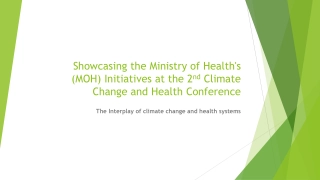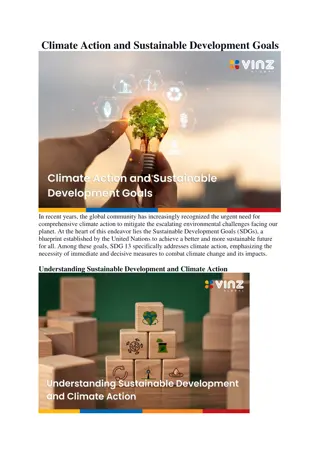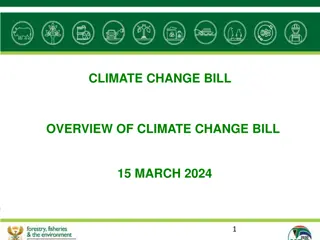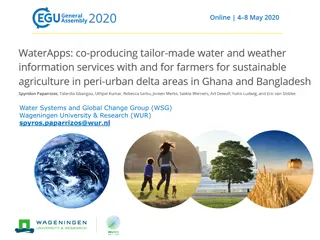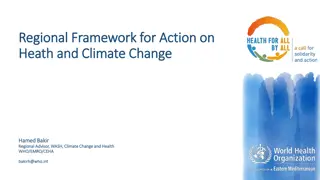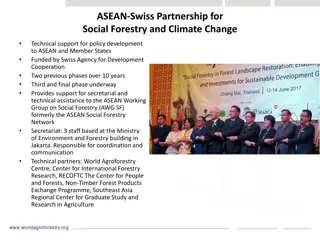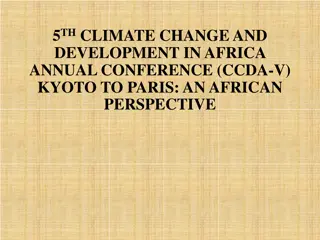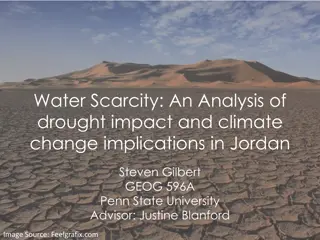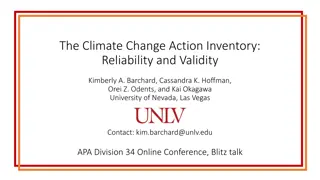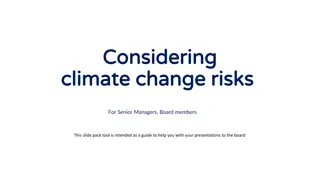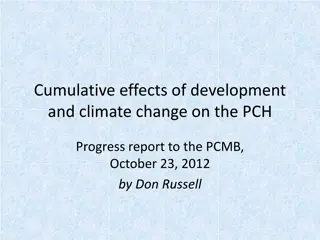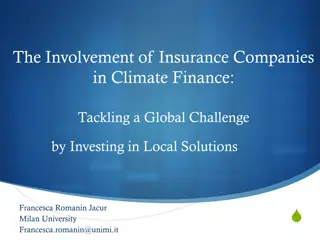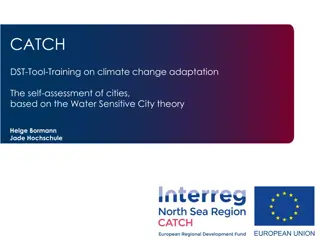Sustainable Development and Climate Change - Integrative Approach and Future Generations
It is crucial to shift towards sustainable development to combat climate change, ensuring a balance between economic, social, and environmental aspects. This multidisciplinary concept aims to foster progress while preserving natural resources for future generations. Climate change poses significant challenges, requiring a global effort to mitigate its effects through sustainable practices.
Download Presentation

Please find below an Image/Link to download the presentation.
The content on the website is provided AS IS for your information and personal use only. It may not be sold, licensed, or shared on other websites without obtaining consent from the author.If you encounter any issues during the download, it is possible that the publisher has removed the file from their server.
You are allowed to download the files provided on this website for personal or commercial use, subject to the condition that they are used lawfully. All files are the property of their respective owners.
The content on the website is provided AS IS for your information and personal use only. It may not be sold, licensed, or shared on other websites without obtaining consent from the author.
E N D
Presentation Transcript
by Dr Bandana Pathak Asst Prof in Economics Shailabala Women s Autonomous College, Cuttack pathakm2012@gmail.com cell-9861156534
Sustainability resources and leaving way for future generation. It is now felt that climate change due to global warming is an outcome of not using resources as per need, but for greed. Sustainable development requires a new integrative approach combining economic theory with the study of use of natural resources. The need of a new multidisciplinary concept has cleared current science, creating the premises of a global view phenomena, within a homogeneous set in which all interact with each other. is a practice of using natural the all rigid economic, boundaries social between and different of environmental
There development. The concept emerged in the '80s as an attempt progress, involving consumption of raw materials and finding ways to save these resources and eliminate pollution factors. Sustainable development combines all these three economic, social and environmental components, while focusing on the human, on the cultural and social progress, interrelationships and, in time, generating a higher level of development embodied in the concept of sustainable development are many create discussions a about between sustainable economic to bridge dimension, however on many technical understood and scientific in their
The seasonal changes over a long period with respect to the growing accumulation of greenhouse gases in the atmosphere. NASA defines climate change as a broad range of burning fossil fuels which add heat trapping gases to Earth s the increased global warming, but also encompass changes such as sea-level rise, ice mass Antarctica, worldwide shifts extreme weather events. climate change phenomenon refers to the global phenomena created atmosphere. These temperature predominantly by phenomena trends described by loss in mountain include Greenland, glaciers the Artic in flower/plant blooming and and
Climate phenomenon. Weather day periods of 30 distinct weather pattern occurs. A but over the long term, the region receives very little rainfall. It has a dry climate. change is the long term can change day, month from hour to year.For hour to year or to years more, however desert might experience a rainy week,
Sustainable principle for goals while at the same time sustaining the ability of natural resources and eco system services upon which the depend. Development meeting human is the development ongoing natural systems to provide the economy and society
The development is 1987 development is development that needs of the ability of future generations to that to meet their own need. modern concept derived mostly Report of sustainable from sustainable the Brundtland present without compromising the
The concepts of needs in particular, the essential which idea of imitating imposed by the state of technology and social organization on the environment s ability to meet present and their future needs. needs pricing the world s poor to should of be given and the
This methods production of crops damage involves preventing adverse effects to soil, water, bio diversity and surrounding . concepts of of environment that or livestock or natural friendly allow without systems. It farming the to human
The goal of sustainable development Care for natural resources . Management of renewable resources Creation life of surrounding ,water and the atmosphere . To provide resources for population without compromising the availability of Without causing environmental damage Without other species and natural eco systems for awareness of the animal and plant the use of present those resources for future generation and creating problems for the survival of
The Indian provided we generation reverse resources is now a matter of concern to the entire world. Because any type of imbalance or any type of degradation of the world s resources gradually affect the entire human civilization and it may cause ecological imbalance. To avoid this taught us the mantra of Vasudhaiba human force of the world should behave as a family and should care for their family. While discussing about the present day modern concept of sustainable development we should remember that it is not only the problem of our area where we live but of our country, about our people and above all of our planet. This article tries to examine the link between and development. concept culture. Our us at free of cost by nature , are precious and should as is sustainable culture for trustee happening of development teaches and these and is not new to resources it depletion which to all are care this of hand valuable property. But the over the next these just of our ancient sages, saints, philosophers and intellectuals Vasudhaiba Kutumbakam Kutumbakam . .The entire natural resources on climate change and its effect sustainable
Life on earth is dependent on an atmosphere greenhouse a layer of gases, primarily water vapour in the lower atmosphere that wrap heat from the sun as it s reflected back from the earth radiating it keeping our planet at a temperature capable of supporting life. Human greenhouse gases. The main is amount of plant life available Methane a atmosphere from farming both from animals such as cattle and arable farming methods including transitional gas used in individual application and home appliances such as refrigerator were key greenhouse gases released now heavily regulated due to their severe impact which included ozone atmosphere back and activity burning generating source of excess carbon dioxide emission which to turn CO2 in oxygen. less paddies and abandoned oil and fluorocarbons and hydro fluorocarbons during the 20th ozone depleting is of fossil fuels currently an excess of long reduced the lived the deforestation has more potent but abundant greenhouse gas enters the wells, Chloro once widely century but are on the trapping heat atmosphere depleting as as well well as as trapping heat in the lower
According Intergovernmental Panel on Climate Change (IPCC), the observed effects include: The global approximately 0.65 C over the last 50 years. Eleven of the last 12 years (1995 2006) rank among the 12 warmest years since records began in the 1850s. The rates of warming and of sea level rise have accelerated in recent decades. Many areas, particularly mid- to high-latitude countries, have experienced increases in precipitation and there has been a general increase in the frequency of extreme rainfall. In some regions, such as parts of Asia and Africa, the frequency and intensity of droughts have increased in recent decades. The increased in some areas, such as the North Atlantic, since the 1970s. to the Fourth Assessment Report (2007) of the average surface temperature has increased by frequency of the most intense tropical cyclones has
Global mean surface temperature will rise by 1.1 6.4 C, depending partly on future trends in energy use. Warming will be greatest over land areas and at high latitudes. Heat waves, heavy precipitation events, and other frequent and intense. Sea level rise is expected to continue at an accelerating rate. extreme events will become more
Climate change availability water ,which sustains life in the planet. Changes resources are quality Throughout experiences warming above global level. India will also begin temperature with more summers. Longevity recent years with warmer days models (CO2),concentration and temperature across the globe. has resources on the earth especially a serious impact on the availability of of various various resources in life. . the bio-sphere, bio-diversity and already affecting natural and affecting human human health health and quality of of life the 21st century India experience more is projected variation in the winter than to to seasonal seasonal variation in warming of heat waves across India warmer night a has extended and hotter carbon di-oxide in night temperature gradual rise temperature and in hotter days and this trend is expected to continue. Climate predict
Local temperature combined varieties, conditions can maximize food production as long controlled. weather conditions such sunshine locally cropping as wind rain, , and adapted pattern is with plant soil and as a plant diversification can be
A study on the impact of climate change by the International Monetary Fund, (IMF), shows countries in the tropics will be the worst affected as a result of global warming. For the emerging market economy, a 1 C increase from a temperature of 22 C lowers growth in the same year by 0.9 percentage point, says the report. The accompanying chart shows the effect of a 1 degree rise in temperature on per capita output for several countries.
Name Bangladesh Brazil China Canada UK Indonesia India Malaysia Nigeria Norway Phillipines Russia Saudu Singapore Srilanka Thailand US Source Name of Bangladesh Brazil China Canada UK Indonesia India Malaysia Nigeria Norway Phillipines Russia Saudu Arab Singapore Srilanka Thailand US Source IMF of the the country country Effect -1.29 -1.05 Negligible 0.78 Negligible -1.37 -1.33 -1.37 -1.45 0.82 -1.34 0.83 -1.31 -1.50 -1.39 -1.47 Negligible Effect in in percentage percentage point point Arab IMF Courtsey Courtsey Subrat Subrat Jena/Mint Jena/Mint
Rainfall originate climate will accelerate the hydrologic cycle altering rainfall, magnitude moisture and it will result in an increase in evaporation of surface moisture. Climate change Effect of climate change will affect water cycle. In addition rise in seasonal will have an impact on quality of water and it s potential use of will have number of effect on agriculture. Higher temperature and changing precipitation pattern will severely Agriculture productivity carbon dioxide in the atmosphere. All these will change the vulnerability of the landless and the poor. has a direct relationship with the monsoons which from and timing the Indian of and Arabian sea. A air warmer more rainfall. Warm holds has a direct increase impact the ground on risk of water and river which crop productivity. permanent or sea level will saline intrusion into domestic, agricultural and industrial uses. Climate change affect the production pattern of will different crops. also affected due to increase
Our personal health may seem to relate mostly to prudent behavior, heredity, occupation, local environmental exposures, and health-care access, but sustained population health requires the life supporting services of the biosphere. Populations of all animal species depend on supplies of food and water, freedom from excess infectious disease, and the physical safety and comfort conferred by climatic stability. The world's climate system is fundamental to this life support. A changing climate is likely to affect all these conditions and hence have a powerful impact on human health and well-being. In its Third Assessment Report, the United Nation's IPCC concluded that climate change is projected to increase threats to human health. Climate change can affect human health directly (e.g., impacts of thermal stress, death/injury in floods and storms) and indirectly through changes in the ranges of disease vectors (e.g., mosquitoes), water-borne pathogens, water quality, air quality, and food availability and quality. Global climate change is, therefore, a newer challenge to ongoing efforts to protect human health.
Death and injury due to flooding. Reduced availability of fresh water due to saltwater intrusion. Contamination of water supply through pollutants from submerged waste dumps. Change in the distribution of disease-spreading insects. Health effect on the nutrition due to a loss in agriculture land and changes in fish catch Health impacts associated with population displacement.
The another geo graphic predicted increases .Moose and polar beer populations are and sensitive changes to lake times may affect the food supply for aquatic species may also affect fish spawning .Change in conditions more invasive species which puts pressure on native species. way certain and their range to species environment of move north as interact with one change. The and the plants wildlife temperature is expected isolated habitats to to shift north. Species may at risk most be the changes. Less freezes up ice cover and and break up water and air temperature may favourable make to disease and
There may be break .Increased growth. Drier forests will lead and local condition. Climate faster than local trees can migrate which may case cause Healthy forests can withstand and reduce impact can promote their health and diversity. more insects and disease out free to more intense species will conditions may change stress may affect forest local tree be less suited to them to die off in some area. the of climate change. The crown forests
Milder shorter winter lead to earlier snow melt. Changing rainfall pattern. Changing in water s movement plants. There renewable ways. Increasing water temperature may result in lower water quality as more organisms found in be spread into new northern habitat. between air, soil and may less energy water preservation and water available for are may lakhs. Warm water species
Some further north Species in area due to increased parasites and competition. Hybridization between different animal species (e.g. already being observed due While require precipitation condition are most decline or disappear completely. wildlife species will to southern areas will be forced to move a more favouring habitat. live in small northern southern equerries) to climate change. animals will narrow and is some a adopt, species of that range temperature and likely to
Wildlife production Relatively between predators and prey Survival Rates of disease in wild life species The availability of food and habitat
Following are some more likely effect of climate change in Odisha temperature above 45 degree C) and pro-longed heat waves rainfall reduced ground water recharging potential Late monsoon onset and more pre-monsoon rainfall Reduced monsoon and winter rainfall Less rainfall in June and October More number of cloudy days Increased day and night temperature in post monsoon followed by summer Extended summer up to June Increased number of hot, humid summer days in coastal areas Warm and short winter with fewer cold nights in western Odisha More frequent extreme weather events such as hot extremes (maximum More number of very heavy rainy days More number of low-intensity low-pressures at the Bay of Bengal More intensive tropical cyclones with larger peak wind speeds and heavier Increased risk of draught and flood during monsoon Intense storms resulting in loss of the rain water as direct runoff resulting in
IPCC defined adaptation (to climate change) as initiative and measure to vulnerability of natural and human system against climate change effect. Vulnerability defined as the degree to which a system is adverse effects of climate change including climate variability and extremes. reduce the to climate change was susceptible to and work to cope with,
Adaptation capacity Economic ground Technology Geo-engineering Skill and Social information Institutions Equity
It is often argued in the literature that there is a trade-off between adaptation and mitigation, in that the resources committed to one are not available for the other . This is debatable in practice because the people who bear emission reduction costs or benefits are often different from those who pay or benefit from adaptation measures. There is also a trade off in how much damage from climate change should be avoided. The assumption that it is always possible to trade off different outcomes is viewed as problematic by many people . For economic growth and damages faced by indigenous cultures. example, a trade off might exist between
In a costbenefit analysis, the tradeoffs between climate change impacts, adaptation, and mitigation are made explicit. Cost benefit analyses of climate change are produced using integrated assessment models (IAMs), which incorporate aspects of the natural, social, and economic sciences. In an IAM designed for cost benefit analysis, the costs and benefits of impacts, adaptation and mitigation are converted into monetary estimates. Some view the monetization of costs and benefits as controversial. The "optimal" levels of mitigation and adaptation are then resolved by comparing the marginal costs of action with the marginal benefits of avoided climate change damages.
A common finding of costbenefit analysis is that the optimum level of emissions reduction is modest in the near-term, with more stringent abatement in the longer-term . This approach might lead to a warming of more than 3 C above the pre-industrial level (World Bank, 2010). In most stabilization of GHGs leading to warming of 2.5 C. No models suggest that the optimal policy is to do nothing, i.e., allow "business-as-usual" emissions. models, benefits exceed costs for
Crop diversification : growing rainfall uplands to perform better under pro-longed soil moisture stress in kharif Non-crop Variation: HYV tolerant /resisant to alternative temperature regions New methods of rice cultivation Preference to micro transplanting Altered sowing time Efficient fertilizer use Integrated post management Drought and flood management Land management Catchment management non-fodder crops in and hybrids of vegetables Rice culture: cultivation techniques such as
Odisha has experienced around 952 small cyclones and 451 tornadoes between 1891 and 1970. From 1901 to1981 there were 380 cyclones, of which 272 resulted from depressions in the Bay of Bengal. 29 of these cyclones have been devastating. A study of the effects of natural disaster reveals that between 1963and 1999, Odisha experienced 13 major disaster, which killed 22,228 people (state government figure, non-government figure puts the toll at around 40,000) and rendered 34,21,000 people homeless. The 1999 super cyclone affected places like Bhubaneswar and Nayagarh, which were never traditionally cyclone prone. While 2001 drought parched fields in coastal districts, the unprecedented floods of 2001 submerged 219 blocks of the state s 30 districts .
Period Average annual property lost and damaged due to disaster ( in Rs Crores) 14.18 67.33 383.50 1970s 1980s 1990s
This natural resources affecting environment of the planet. It is now a matter of common interest as it is attacking on our common property. So collective effort in this regard is necessary. The problem of climate change is a big one and the causes are many and to counter it, is a difficult task. It is not the problem of any region or country, it is the context; at least our philosophers face this problem. A determined collective effort and change in our attitude towards use of natural resources will solve the problem to some extent. Proper regular scientific monitoring is necessary to save our planet earth from beings. article shows that is the root cause of climate change, which is the habit of careless attitude towards problem of our planet. In Indian by immensely it can be said undoubtedly that if we will follow practices as that cultural advised our benefit ancient scholars, sages, and can be prepare us to education, awareness, effective this government interest policies all and living problem for the common of the


